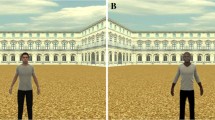Abstract
This study aimed at determining whether the size of reachable space is affected by the level of danger of some everyday manipulable objects. Two possibilities are examined: Dangerous objects affect the size of reachable space because of long-term semantic knowledge of their potential hurtful value or the on-line relation between objects’ dangerous attributes and the body. The experimental paradigm combined the danger value (dangerous/not dangerous) and the orientation of objects (e.g. pointing away from/towards the perceiver). Reachability judgments measured the size of peripersonal space, and perception of objects’ danger was estimated through questionnaires. Results revealed that, whatever the estimated level of objects’ danger, the extent of peripersonal space was reduced when the threatening part of dangerous objects was oriented towards participants, not when oriented away. This suggests that the characteristics of the here and now body-objects interaction are crucial in affecting the boundary of peripersonal space.


Similar content being viewed by others
References
Barsalou LW (2008) Grounded cognition. Ann Rev Psychol 59:617–645
Bartolo A, Coello Y, Delepoulle S, Edwards MG, Endo S, Wing AM (2009) Neurobiological basis of reachability judgement: an fMRI study, In: Proceedings of the 14th international conference on functional mapping of the human brain mapping, San Francisco, USA
Coello Y, Delevoye-Turrell Y (2007) Embodiment, space categorisation and action. Conscious Cogn 16:667–683
Costantini M, Ambrosini E, Tieri G, Sinigaglia C, Committeri G (2012) Where does an object trigger an action? An investigation about affordances in space. Exp Brain Res 207:95–103. doi:10.1007/s00221-010-2435-8
Delevoye-Turrell Y, Bartolo A, Coello Y (2010) Motor representation and the perception of space. In: Gangopadhyay N (ed) Perception, Action and Consciousness. Oxford University Press, Oxford
Dosey MA, Meisels M (1969) Personal space and self-protection. J Pers Soc Psychol 11:93–97
Efron B, Tibshirani RJ (1993) An introduction to the bootstrap. Chapman & Hall, London
Felipe NJ, Sommer R (1966) Invasions of personal space. Soc Probl 14:206–214
Fischer MH, Zwaan RA (2008) Embodied language: a review of the role of the motor system in language comprehension. Q J Exp Psychol 61:825–850
Graziano MSA, Cooke DF (2006) Parieto-frontal interactions, personal space, and defensive behavior. Neuropsychologia 44:845–859
Holmes NP, Spence C (2004) The body schema and the multisensory representation(s) of peripersonal space. Cogn Process 5(2):94–105
Hommel B (2009) Action control according to TEC (theory of event coding). Psychol Res 73:512–526. doi:10.1007/s00426-009-0234-2
Iachini T (2011) Mental imagery and embodied cognition. J Ment Imagery 35(4–5):1–26
Jeannerod M (2006) Motor cognition: what actions tell the self. Oxford University Press, Oxford
Làdavas E, Serino A (2008) Action-dependent plasticity in peripersonal space representations. Cognitive Neuropsych 25:1099–1113
Milner AD, Goodale MA (1995) The visual brain in action. Oxford University Press, Oxford
Previc FH (1998) The neuropsychology of 3-D space. Psychol Bull 124:123–164
Rizzolatti G, Fadiga L, Fogassi L, Gallese V (1997) The space around us. Science 277:190–191
Stein BE, Meredith MA (1993) The merging of the senses. MIT, Cambridge
Witt JK, Proffitt DR (2008) Action-specific influences on distance perception: a role for motor simulation. J Exp Psychol Human 34:1479–1492
Acknowledgments
We thank Lucie Barube for her help in collecting and analysing the data. The research was supported by grants from Charles de Gaulle-University Lille 3 and ANR CONTINT from French Ministry of Research.
Conflict of interest
This supplement was not sponsored by outside commercial interests. It was funded entirely by ECONA, Via dei Marsi, 78, 00185 Roma, Italy.
Author information
Authors and Affiliations
Corresponding author
Rights and permissions
About this article
Cite this article
Coello, Y., Bourgeois, J. & Iachini, T. Embodied perception of reachable space: how do we manage threatening objects?. Cogn Process 13 (Suppl 1), 131–135 (2012). https://doi.org/10.1007/s10339-012-0470-z
Published:
Issue Date:
DOI: https://doi.org/10.1007/s10339-012-0470-z




